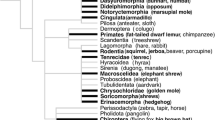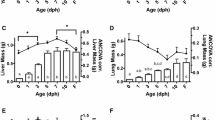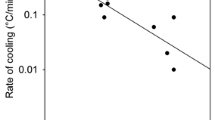Abstract
White mice are ubiquitous laboratory animals and have been extensively studied. To reveal potential undiscovered traits, we tested the hypothesis that during development, when heat loss in mouse pups is high, they can use daily torpor for energy conservation. We determined at what age individual mouse pups are able to defend their body temperature at room temperature (ambient temperature, Ta = 20 °C) and whether they could use torpor from that time. Initially at 5/6 days (body mass, BM ~ 3 g), still naked mice cooled rapidly. In contrast, at ~ 14 days (BM ~ 6 g), they could maintain a high, constant body temperature and, therefore, had reached competent endothermy. These mouse pups at ~ 20% of adult BM were able to enter into and arouse from torpor as determined via the rate of oxygen consumption; this was the case for both individuals that were exposed to a cooling regime as well as those that were not. During torpor, metabolism fell by up to > 90% and torpor lasted for up to 12 h. As mice grew, torpor was still used but was less pronounced. Our study shows that although the physiology of laboratory mice has been widely examined, their functional capabilities have still not been fully revealed, which has implications for biomedicine. Our and other developmental data suggest that because torpor is so efficient in conserving energy, it is likely to be used during the growth phase by diverse mammals and birds to survive energetic and thermal challenges.




Similar content being viewed by others
References
Barak O, Geiser F, Kronfeld-Schor N (2019) Flood-induced multiday torpor in golden spiny mice Acomys russatus. Aust J Zool 66:401–405. https://doi.org/10.1071/ZO19061
Boersma PD (1986) Body temperature, torpor, and growth in chicks of fork-tailed storm-petrels (Oceanodroma furcata). Physiol Zool 59:10–19
Boyer BB, Barnes BM (1999) Molecular and metabolic aspects of mammalian hibernation. Bioscience 49:713–724
Carey HV, Andrews MT, Martin SL (2003) Mammalian hibernation: cellular and molecular responses to depressed metabolism and low temperature. Physiol Rev 83:1153–1181
Dausmann KH, Warnecke L (2016) Primate torpor expression: ghost of the climatic past. Physiology 31:398–408
Dawson WR, Evans FC (1960) Relation of growth and development to temperature regulation in nestling Vesper Sparrows. Condor 62:329–340
Eichhorn G, Groscolas R, Le Glaunec G, Parisel C, Arnold L, Medina P, Handrich Y (2011) Heterothermy in growing king penguins. Nat Commun 2:435. https://doi.org/10.1038/ncomms1436
Eto T, Sakamoto SH, Okubo Y, Koshimoto C, Kashimura A, Morita T (2014) Huddling facilitates expression of daily torpor in the large Japanese field mouse Apodemus speciosus. Physiol Behav 133:22–29
Fernandez-Verdejo R, Ravussin E, Speakman JR, Galgani JE (2019) Progress and challenges in analyzing rodent energy expenditure. Nat Methods 16:797–799
Geiser F (2008) Ontogeny and phylogeny of endothermy and torpor in mammals and birds. Comp Biochem Physiol A 150:176–180
Geiser F, Brigham RM (2012) The other functions of torpor. In: Ruf T, Bieber C, Arnold W, Millesi E (eds) Living in a seasonal world. Springer, Berlin, pp 109–121 https://doi.org/10.1007/978-3-642-28678-0_10
Geiser F, Westman W, McAllan BM, Brigham RM (2006) Development of thermoregulation and torpor in a marsupial: energetic and evolutionary implications. J Comp Physiol B 176:107–116
Geiser F, Wen J, Sukhchuluun G, Chi QS, Wang DH (2019) Precocious torpor in an altricial mammal and the functional implications of heterothermy during development. Front Physiol 10:469
Giroud S, Zahn S, Criscuolo F, Chery I, Blanc S, Turbill C, Ruf T (2014) Late-born intermittently fasted juvenile garden dormice use torpor to grow and fatten prior to hibernation: consequences for ageing processes. Proc R Soc B 281:20141131. https://doi.org/10.1098/rspb.2014.1131
Hayssen V, Lacy RC (1985) Basal metabolic rates in mammals: taxonomic differences in the allometry of BMR and body mass. Comp Biochem Physiol A 81:741–754
Hill RW (1976) The ontogeny of homeothermy in neonatal Peromyscus leucopus. Physiol Zool 49:292–306
Holloway JC, Geiser F (2000) Development of thermoregulation in the sugar glider Petaurus breviceps (Marsupialia:Petauridae). J Zool 252:389–397
Hudson JW, Scott IM (1979) Daily torpor in the laboratory mouse, Mus musculus var. Albino. Physiol Zool 52:205–218
Juskaitis R (2005) Daily torpor in free-ranging common dormice (Muscardinus avellanarius) in Lithuania. Mamm Biol 70:242–249
Koizumi A, Wada Y, Tuskada M, Kayo T, Naruse M, Horiuchi K, Mogi T, Yoshioka M, Sasaki M, Miyamaura Y, Abe T, Ohtomo K, Walford RL (1996) A tumor preventive effect of dietary restriction is antagonized by a high housing temperature through deprivation of torpor. Mech Ageing Dev 92:67–82
Kronfeld-Schor N, Dayan T (2013) Thermal ecology, environments, communities, and global change: energy intake and expenditure in endotherms. Annu Rev Ecol Evol Syst 44:461–480
Lefcheck JS (2016) piecewiseSEM: piecewise structural equation modeling in R for ecology, evolution, and systematics. Methods Ecol Evol 7:573–579
Lummaa V, Clutton-Brock T (2002) Early development, survival and reproduction in humans. Trends Ecol Evol 17:141–147
Metcalfe NB, Monaghan P (2001) Compensation for a bad start: grow now pay later? Trends Ecol Evol 16:254–260
Morrison P, Petajan JH (1962) The development of temperature regulation in the opossum, Didelphis marsupialis virginiana. Physiol Zool 35:52–65
Nowack J, Stawski C, Geiser F (2017) More functions of torpor and their roles in a changing world. J Comp Physiol B 187:889–897
Nuesslein-Hildesheim B, Imai-Matsumura K, Doering H, Schmidt I (1995) Pronounced juvenile circadian core temperature rhythms exist in several strains of rats but not in rabbits. J Comp Physiol B 165:13–18
Pinheiro J, Bates D, DebRoy S, Sarkar D, R Core Team (2019). nlme: linear and nonlinear mixed effects models_. R package version 3.1-140, https://CRAN.R-project.org/package=nlme. Accessed 19 Nov 2019
Ruf T, Geiser F (2015) Daily torpor and hibernation in birds and mammals. Biol Rev 90:891–926
Schubert KA, Boerema AS, Vaanholt LM, de Boer SF, Strijkstra AM, Daan S (2010) Daily torpor in mice: high foraging costs trigger energy-saving hypothermia. Biol Lett 6:132–135
Swoap SJ, Gutilla MJ (2009) Cardiovascular changes during daily torpor in the laboratory mouse. Am J Physiol 297:R769–R774
Tomlinson S, Withers PC, Cooper CE (2007) Hypothermia versus torpor in response to cold stress in the native Australian mouse Pseudomys hermannsburgensis and the introduced house mouse Mus musculus. Comp Biochem Physiol A 148:645–650
Turbill C, Bieber C, Ruf T (2011) Hibernation is associated with increased survival and the evolution of slow life histories among mammals. Proc R Soc B 278:3355–3363
Wacker CB, McAllan BM, Körtner G, Geiser F (2017) The role of basking in the development of endothermy and torpor in a marsupial. J Comp Physiol B 187:1029–1038
Withers PC, Cooper CE, Maloney SK, Bozinovic F, Cruz-Neto AP (2016) Ecological and environmental physiology of mammals. Oxford University Press, Oxford
Acknowledgements
We thank Joanna Fietz, Sharon McGavin, Gerhard Körtner, Gemma Morrow and Chris Wacker for their support and the University of New England for laboratory facilities.
Author information
Authors and Affiliations
Corresponding author
Additional information
Communicated by H. V. Carey.
Publisher's Note
Springer Nature remains neutral with regard to jurisdictional claims in published maps and institutional affiliations.
Rights and permissions
About this article
Cite this article
Renninger, M., Sprau, L. & Geiser, F. White mouse pups can use torpor for energy conservation. J Comp Physiol B 190, 253–259 (2020). https://doi.org/10.1007/s00360-020-01263-8
Received:
Revised:
Accepted:
Published:
Issue Date:
DOI: https://doi.org/10.1007/s00360-020-01263-8




